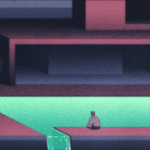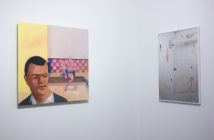I am viewing Providence College--Galleries’ inaugural digital exhibition, Geographically Indeterminate Fantasies, curated by Art F City, and on view in its “IRL” physical form through July 2nd at GRIN, from a window seat of an Amtrak train. The railroad, a modern signifier of changing notions of physical and cultural fluidity, is a fitting place to view the exhibition, which thematizes and embodies ambiguous locality, presenting the work in multiple venues, on the web and IRL.
Geographically Indeterminate Fantasies consists mostly of GIFS, aptly described in the exhibition’s accompanying curatorial statement as “the aging poster child of the placeless image.” Many were specially commissioned for the exhibition, which also includes longer-form digital pieces and web environments. Art F City’s curatorial team of Paddy Johnson and Michael Anthony Farley offer us two viewing options: the private, screen-based experience of Providence College--Galleries’ web space, and the public, habitually aesthetic white cube space of Providence’s GRIN, transformed by projections, a neon sculpture, and monitors installed on every imaginable surface. These modalities are not without large interpretive repercussions for the work and the curatorial project on the whole; while a large portion of the art is represented in both venues, some fares better in one. But ultimately Geographically Indeterminate Fantasies, GIF, offers a poetic meditation on our global homelessness. And in its presentation of artwork in multiple venues simultaneously, it subtly performs the decentralized world that it argues.
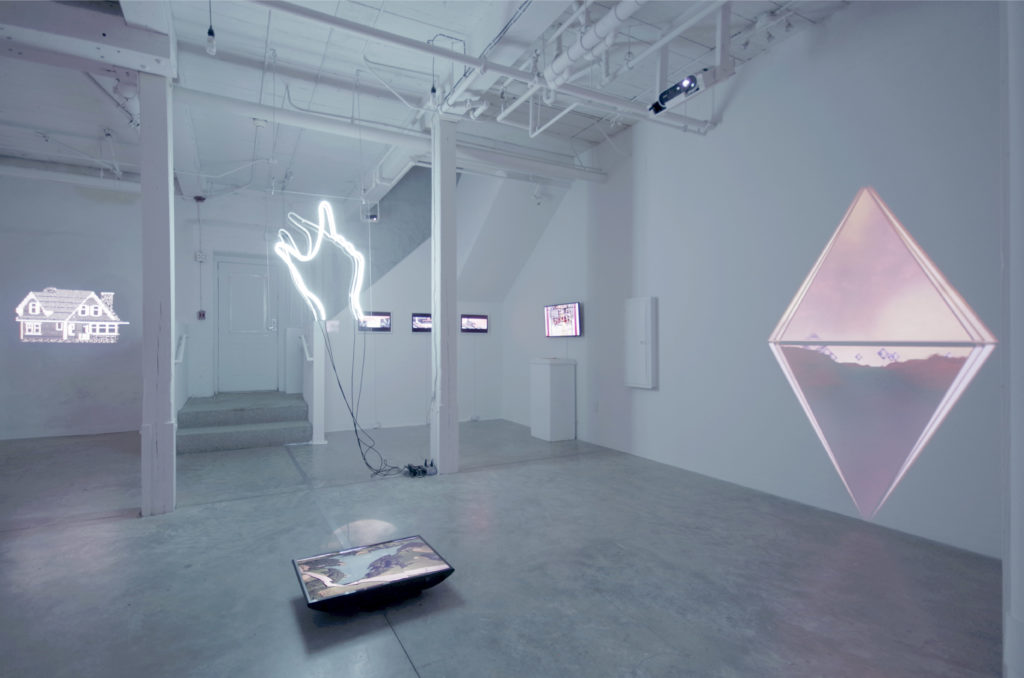
Geographically Indeterminate Fantasies Installation at GRIN June 4 - July 2. (Left to Right) Nicolas Sassoon, “Favourites,” 2012; Victoria Fu, “Pinch-Zoom,” 2015; Hugo Moreno, “Art Department: Walls,” 2015; Wickerham & Lomax, "BOY’DegaEdited4Syndication”, 2014; Giselle Zatonyl, “Modular Landscape (Ky plon)”, 2016; and Clement Valla, “Approximate GIFs from Google Earth (46°42’19.50′′N, 7° 5’20.26′′E)”, 2015 (foreground). Courtesy of GRIN.
As art worlds centered in New York, LA, and Berlin, are rendered largely uninhabitable through gentrification, the fantasy “artist” has become increasingly geographically undetermined. Art F City presents a notably diverse selection of artists from around the US, including those from Baltimore, Providence, New York, Los Angeles, and abroad, from Toronto, Argentina, China, whose work puts forth imagined, digital geographies, broadly defined. The GIFS on view, evocative of landscapes, planets, maps, and societies, are all, in the words of the curators, “open enough for us to project our own potential fictions upon them,” although most are united in their presentation of dystopian, empty worlds marked by excessive consumption and dark humor.
In Eva Papamargariti’s Sisyphean Black Friday, typical big-box purchases- a washing machine, flat screen television, tee-shirts- await shoppers on a steep, lonely cliff which viewers ascend toward never but never land upon. Jonathan Monaghan’s commissioned GIFS act as tantalizing film stills for the original 20-minute film Escape Pod. Monaghan may as well be George Bataille working for Pixar. In his meticulously detailed Narnia, a golden calf leads us through doors and anuses toward Duty-Free Shopping areas and glacial seascapes. Not to be missed is the unforgettable water landing of a UFO- a flying layer cake of architectural facades with a pink pair of testicles as its sagging foundation.
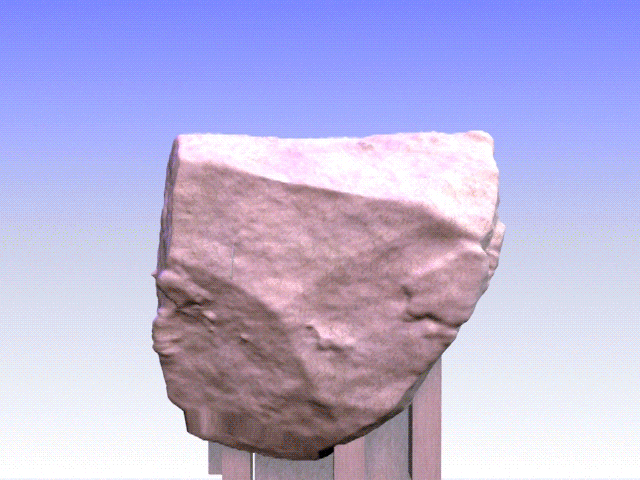
Eva Papamargariti, Black Friday, 2014. Animated GIF. Courtesy of GRIN.
Some GIFS work better IRL: for example, Giselle Zatonyl’s Modular Landscape (Kyplon). Projected onto the wall and thus integrated into GRIN’S physical architecture, Zatonyl’s, GIFS are transformed into trompe l’eoil rhombizoid and diamond- shaped windows through which we view seascapes and terrain that feels plucked from the game Myst. These GIF- Windows flank Victoria Fu’s Pinch Zoom, a flashing neon hand, which gestures the familiar thumb and forefinger pinch-zoom motion typical of navigation on a mobile device. Conversely, while better suited for private, extended viewing than in its kiosk iteration at GRIN, Wickerham and Lomax’s masterful duoxduox.com offers an un-categorizable, entrancing navigation experience that combined digital and architectural spaces--Netflix turned Baltimore-based gay bar--that kept me delightfully confused but turned on from New Haven to Westerly.
Ying Maio’s work transforms the stifling brevity of the GIF form into a hypnotic and coyly critical rumination on China’s web censorship. English and Chinese text objects float across open browser windows whose content has been blocked and is thus “unavailable.” “To be missed is another kind of beauty” reads the English one, suggesting the aesthetically generative potential of a China’s web censorship. This work was poignant in both venues but felt especially critical when viewed in the context of my own browser, of whose censorship I am rarely cognizant.
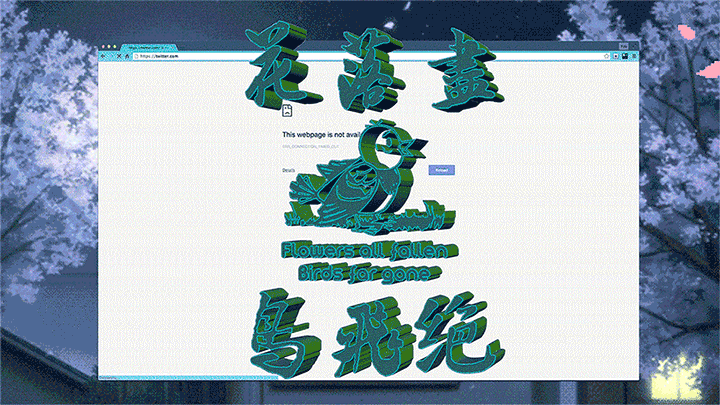
Ying Miao, Flowers All Fallen, Birds Far Gone, 2015, animated GIF. Courtesy of GRIN.
The Maio and Wickerham and Lomax work have stayed with me since seeing the IRL exhibition longer than most, but at no fault of the other artists on display. The exhibition’s abundance of stellar work, arguably the show’s greatest strength, also renders much of it indistinct by virtue of its quantity, not quality. So too goes the unifying framework of the show. Case in point of this clouding generosity: no less than fourteen Hito Steryl essays, included as a work of art, present invaluable paradigms for further understanding the politics that the work on view interrupts- a canon of concepts that could easily populate an entire semester’s Introduction to Neoliberal Aesthetics.
However, in an age of seemingly endless mobility, it remains rare for this many acclaimed international artists to be exhibiting under one umbrella in Providence. PCG Director Jamilee Lacy and GRIN are making important strides to diversify and increase the rigor of Providence’s art world, which remains largely regional.
- Eva Papamargariti, Black Friday, 2014. Animated GIF. Courtesy of GRIN.
- Ying Miao, Flowers All Fallen, Birds Far Gone, 2015, animated GIF. Courtesy of GRIN.
- Geographically Indeterminate Fantasies Installation at GRIN June 4 – July 2/ (Left to Right) Nicolas Sassoon, “Favourites,” 2012; Victoria Fu, “Pinch-Zoom,” 2015; Hugo Moreno, “Art Department: Walls,” 2015; Wickerham & Lomax, “BOY’DegaEdited4Syndication”, 2014; Giselle Zatonyl, “Modular Landscape (Ky plon)”, 2016; and Clement Valla, “Approximate GIFs from Google Earth (46°42’19.50′′N, 7° 5’20.26′′E)”, 2015 (foreground). Courtesy of GRIN.
- Hugo Moreno, “Art Department Walls”, 2015, 9 animated GIFs drawn from Moreno’s video “Art Department Walls.” Courtesy of GRIN.





